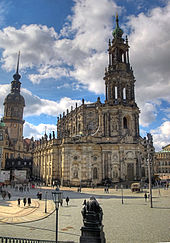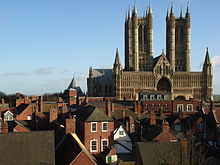Cathedral
![]()
This article is about the Episcopal church. For other church buildings, see Old Cathedral and New Cathedral; for the novel The Cathedral; for the computer game The Cathedral (computer game).
![]()
Episcopal church is a redirect to this article. See also: Bishop's chapel.
A cathedral or cathedral church (Latin ecclesia cathedralis "church of the cathedra"), also episcopal church, is a church in which a bishop resides and which contains the cathedra as his seat. As the principal and mother church of a diocese, it is the place from whose cathedra the local bishop performs the functions of preaching, liturgical ministry, and pastoral oversight associated with his office. The designation of a church as a cathedral does not imply any statement about the architectural style, the size or the time of origin of the building.
Cathedrals exist in episcopal churches such as the Roman Catholic Church, the Orthodox, Anglican and Old Catholic churches, and individual Lutheran and Methodist churches.
In the lists of cathedrals and cathedrals, cathedrals are listed by continent.

Catholic Court Church, Cathedral of the Diocese of Dresden-Meissen
.JPG)
Pisa Cathedral, Roman Catholic Cathedral of the Archdiocese of Pisa

Florence Cathedral, Italy

Lincoln Cathedral, Anglican Cathedral of the Diocese of Lincoln
Cathedrals in the Roman Catholic Church
According to the understanding of the Second Vatican Council (Sacrosanctum Concilium n. 41), the cathedral is the primary place where the People of God of a particular Church (diocese) gather under the leadership of the bishop, most especially in the celebration of the liturgy; it is in the cathedral that the unity and order of the particular Church are expressed, and it is from the cathedra that the local bishop carries out his ministry of "teaching, sanctifying and governing" his diocese.
In the canon law of the Roman Catholic Church, the cathedral therefore has a special legal status as a church. A solemn consecration is prescribed (can. 1217 CIC, can. 871 CCEO). The bishop usually takes possession of his diocese in the cathedral (enthronement), and his papal instrument of appointment must be read there (can. 382 CIC). It is also designated as the place for the funeral celebration of the bishop (can. 1011 CIC). The bishop is required to celebrate Mass frequently in the cathedral, especially on feast days and other solemn occasions (can. 389 CIC), and to administer the sacrament of Holy Orders there (can. 1011 §1 CIC). The Eucharist must be kept in a cathedral (can. 934 §1 CIC).
The canon law of the Eastern Catholic Churches requires the bishop to see to it that at least parts of the divine services are celebrated in the cathedral even daily according to the regulations of the respective rite church (can. 199 §2 CCEO) and that he himself presides over the celebration in the cathedral or in another church regularly and especially on feast days and other feasts of great popular interest (can. 199 §3 CCEO).
In the Roman Catholic Church, there are 3015 cathedrals worldwide, as well as 296 con-cathedrals, 423 former cathedrals and 41 pro-cathedrals, according to GCatholic.org's listing.
The highest-ranking church of the Roman Catholic Church is the Lateran Basilica, the cathedral of the diocese of Rome and the bishop's seat of the Pope. It bears the honorary title of Mother and Head of all the churches of the world. The consecration day of the Lateran Basilica is celebrated in the Roman Catholic Church as a feast in the rank of a feast of the Lord.

Choir and apse of the Lateran Basilica with cathedra
Cathedral churches and episcopal see
Cathedrals can lose their title due to the transfer of bishoprics or the abolition of bishoprics through the Reformation or secularisation.
Cathedral
In the Roman Catholic Church, after the transfer of an episcopal see or the merger of two dioceses, a former episcopal church sometimes continues as the second cathedral of the diocese, and is called a concathedral or co-cathedral. The cathedral of the Archdiocese of Munich and Freising continues to be known by its old name, Frauenkirche, while the original episcopal see, Freising Cathedral, is now Konkathedrale. The Church of the Most Holy Name of Jesus in Jerusalem is called the Latin Patriarch's Concathedral in Jerusalem because the cathedral rank is reserved for the Church of the Holy Sepulchre.
Examples of other concathedrals are:
- St. John's Co-Cathedral, Malta in Valletta
- Gurk Cathedral, Cathedral of the Diocese of Gurk-Klagenfurt
- St. Mary's Church (Gdansk), concathedral of the Archbishopric of Gdansk
- Basilica of St. Peter (Dillingen), concathedral of the diocese of Augsburg
- Assumption of the Virgin Mary (Bolzano), Cathedral of the Bolzano-Bressanone Diocese
- Cathedral St. Petri (Bautzen), concathedral of the diocese Dresden-Meißen
- Cathedral of the Memory of the Seven Sorrows of Mary, Poprad, Slovakia
- Cathedral Church of St. Eberhard (Stuttgart), concathedral of the diocese of Rottenburg-Stuttgart
- St. Nicholas Cathedral, in Prešov, Cathedral of the Archbishopric of Košice
- Cathedral of Christ Transformation (Varnsdorf), the Old Catholic Church in the Czech Republic
- Bartholomew Church (Gdansk), concathedral of the Greek Catholic Eparchy of Wroclaw-Gdansk
- San Bartolomeo, Concathedral of the Archdiocese of Messina-Lipari-Santa Lucia del Mela, Lipari Island, Italy
- Santa María Cathedral, in Castellón, Cathedral of the Diocese of Segorbe-Castellón de la Plana
Procathedral
Provisional or temporary episcopal churches are called procathedrals and usually retain this designation even after the episcopal see has been moved again. Especially in the case of newly established dioceses, it can happen that another church temporarily functions as the bishop's seat until the completion of a planned cathedral.
Questions and Answers
Q: What is a cathedral?
A: A cathedral is a Christian church that is the seat of a Bishop and the central church of a diocese.
Q: What denominations have cathedrals?
A: Cathedrals can be found in the Roman Catholic, Eastern Orthodox, Oriental Orthodox, Anglican as well as some Lutheran churches. In the Greek Orthodox Church, both "kathedrikos naos" and "metropolis" are used to describe the same thing.
Q: Are there variations on how cathedrals are used?
A: Yes, some pre-Reformation cathedrals in Scotland now within the Church of Scotland still retain the term cathedral despite not having bishops due to their Presbyterian polity. Additionally, people may incorrectly refer to any large important church as a cathedral.
Q: Are there other kinds of great churches in Western Europe besides cathedrals?
A: Yes, abbeys are another kind of great church in Western Europe.
Q: How do Minster churches differ from cathedrals?
A: Minster churches such as those found at Strasbourg and York, Lincoln and Southwell were originally served by canons living in community or may have been an abbey prior to the Reformation.
Q: What does 'Metropolis' mean when referring to Greek Orthodox Churches?
A: Metropolis is more common than kathedrikos naos when referring to Greek Orthodox Churches and it means "mother city".
Q: Do all dioceses have bigger churches than their cathedral ? A: No , some dioceses have other churches that are bigger than their cathedral .
Search within the encyclopedia